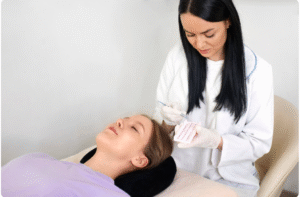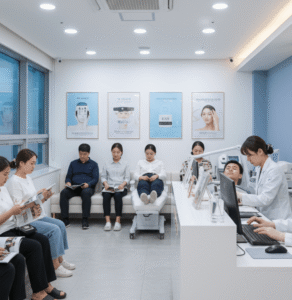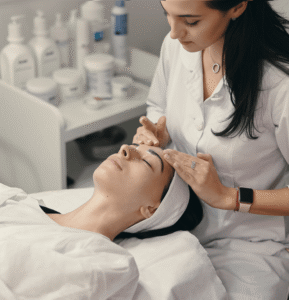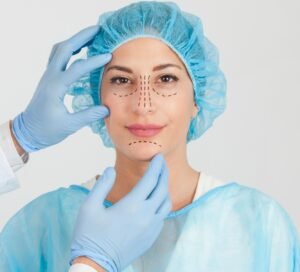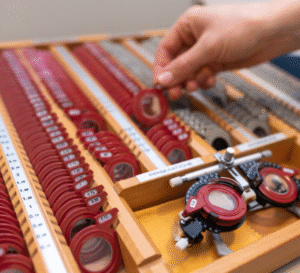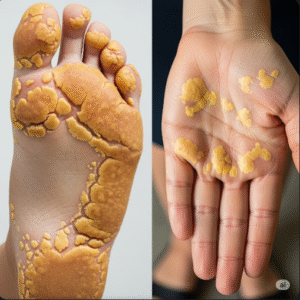What It Is
Defining Chronic Hives
→ Chronic hives (chronic urticaria) is a skin condition where itchy welts or swelling (angioedema) appear almost daily or frequently for longer than 6 weeks.
→ Unlike acute hives, which usually resolve quickly after an allergic reaction, chronic hives often have no obvious trigger and may persist for months or years.
→ In Korea, dermatologists use structured evaluation protocols to determine possible causes, guide treatment, and rule out systemic diseases.
Key Characteristics
- Itchy, raised welts that appear and disappear within 24 hours, but recur regularly
- Swelling (angioedema) in lips, eyelids, hands, or feet in some cases
- No consistent trigger in many patients (chronic spontaneous urticaria)
- May worsen at night or during stress
- Can be associated with autoimmune or thyroid disease
Why It’s Done
Main Reasons for Evaluation
➡ Identify Underlying Triggers – Chronic hives may be linked to autoimmune issues, infections, or medications.
➡ Rule Out Systemic Diseases – Conditions such as lupus, thyroid disease, or chronic infections may mimic hives.
➡ Guide Treatment Plan – Evaluation ensures correct therapy is chosen for severity.
➡ Exclude Allergies – Helps determine if food, drug, or environmental allergies are relevant.
➡ Improve Quality of Life – Proper diagnosis reduces frustration in patients with unexplained symptoms.
Alternatives
Non-Medical Options
- Symptom Diary → Tracking flare-ups, diet, and activities to identify patterns.
- Lifestyle Adjustments → Avoiding alcohol, NSAIDs, stress, or overheating that may worsen hives.
- Stress Reduction → Mind-body therapies like yoga or relaxation to reduce flare intensity.
Medical Alternatives
→ If full evaluation is not possible, symptomatic treatment may be started directly with:
- Antihistamines (non-sedating, stepwise increase if needed)
- Short corticosteroid course for acute flares
- Empirical treatment for infections or thyroid imbalance
But long-term care is best guided by structured evaluation.
Preparation
Before Evaluation in Korea
➡ Detailed History – Patients are asked about frequency, duration, triggers, and associated swelling.
➡ Medication Review – NSAIDs, antibiotics, and ACE inhibitors are common culprits.
➡ Diet and Lifestyle Review – Alcohol, spicy foods, and stress often worsen symptoms.
➡ Prior Treatments – Doctors check what antihistamines or steroids have been tried before.
➡ Family and Personal History – Autoimmune or allergic history is noted.
How It’s Done
Step 1: Medical History and Physical Examination
→ Dermatologists begin with a comprehensive interview and exam.
- Duration and pattern of hives
- Associated angioedema
- Any systemic symptoms (fever, joint pain, fatigue)
- Examination of skin and mucous membranes
Step 2: Basic Laboratory Tests
→ In Korea, the following are commonly ordered:
- Complete blood count (CBC) – To check infection or anemia
- Erythrocyte sedimentation rate (ESR) and C-reactive protein (CRP) – To detect inflammation
- Liver and kidney function tests – To rule out systemic causes
- Thyroid function tests and antibodies – As autoimmune thyroid disease is strongly linked to chronic hives
Step 3: Allergy and Immune Testing
→ If suspected triggers exist:
- Skin prick test or serum IgE tests for food and environmental allergens
- Autoimmune markers like ANA if connective tissue disease is suspected
- Basophil activation tests (available in some Korean hospitals) for autoimmune urticaria
Step 4: Infection Screening
→ Chronic hives can be linked to infections, so tests may include:
- H. pylori testing (stomach bacteria linked to chronic urticaria in some studies)
- Hepatitis B or C screening in select cases
- Parasitic infection checks in persistent, unexplained cases
Step 5: Provocation and Challenge Tests
→ For physical urticaria (triggered by heat, cold, pressure, or exercise), doctors may perform:
- Ice cube test (cold urticaria)
- Heat or exercise tests (cholinergic urticaria)
- Pressure tests (delayed pressure urticaria)
Step 6: Treatment Trial
→ If no underlying cause is found (common in chronic spontaneous urticaria), doctors begin a stepwise antihistamine treatment trial.
- Helps confirm diagnosis while ruling out alternative skin diseases
Recovery
Immediate Recovery After Evaluation
- Blood tests and allergy screenings provide answers within days to weeks.
- Patients may feel relief simply from knowing there is a structured plan.
Long-Term Recovery
→ In many cases, evaluation reveals no clear trigger, and the focus shifts to symptom control.
→ With proper management, most patients achieve stable remission within months to years.
→ Korean clinics emphasize long-term follow-up and medication adjustment to minimize relapses.
Complications
Risks Without Proper Evaluation
- Misdiagnosis → Hives may be mistaken for drug reaction, eczema, or vasculitis.
- Missed Underlying Conditions → Thyroid disease, lupus, or infection left untreated.
- Overuse of Steroids → Without proper diagnosis, patients may rely on long-term steroids, causing harm.
- Chronic Distress → Persistent itching and swelling impair quality of life.
Risks With Evaluation
- Blood Test Discomfort → Mild pain or bruising from blood draws.
- False Positive Allergy Tests → May lead to unnecessary dietary restrictions.
- Provocation Tests → May temporarily trigger symptoms but are closely monitored.
Treatment Options in Korea
Why Korea Excels in Chronic Hives Evaluation
➡ Comprehensive Diagnostic Protocols – Dermatologists and allergists follow international guidelines.
➡ Access to Advanced Labs – Korean hospitals provide immunologic and autoimmune panels quickly.
➡ Integrated Care – Collaboration between dermatology, allergy, gastroenterology, and endocrinology.
➡ Patient Education Programs – Clinics provide dietary counseling, lifestyle advice, and stress management.
Patient Experience in Korea
- Evaluations are outpatient-based, often completed in 1–2 visits.
- Patients receive a personalized report of possible triggers and test results.
- Korean clinics emphasize combining medical evaluation with symptom tracking apps or diaries.
- Stepwise treatment is adjusted according to evaluation results, with biologic therapy (like omalizumab) considered if refractory.
Conclusion
Chronic hives evaluation in Korea is a structured, step-by-step process designed to uncover potential triggers, rule out systemic disease, and guide treatment.
With history-taking, lab tests, allergy screening, infection checks, and provocation tests, Korean dermatologists ensure patients receive accurate diagnosis and targeted management.
Even when no specific cause is found, Korea’s focus on comprehensive care, symptom control, and patient education ensures long-term improvement and better quality of life.
For patients living with chronic hives, Korea provides some of the most advanced, reliable, and patient-focused evaluation systems worldwide.


